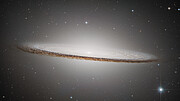As part of ESA/Hubble’s 35th anniversary celebrations, a new image series is being shared to revisit stunning Hubble targets that were previously released. First, a new image of NGC 346 was published. Now, ESA/Hubble is revisiting a fan-favourite galaxy with new image processing techniques.The new image reveals finer detail in the galaxy’s disc, as well as more background stars and galaxies.
Several Hubble images of the Sombrero Galaxy have been released over the past two decades, including this well-known Hubble image from October 2003. In November 2024, the NASA/ESA/CSA James Webb Space Telescope also gave an entirely new perspective on this striking galaxy.
Located around 30 million light-years away in the constellation Virgo, the Sombrero Galaxy is instantly recognisable. Viewed nearly edge on, the galaxy’s softly luminous bulge and sharply outlined disc resemble the rounded crown and broad brim of the Mexican hat from which the galaxy gets its name.
Though the Sombrero Galaxy is packed with stars, it’s surprisingly not a hotbed of star formation. Less than one solar mass of gas is converted into stars within the knotted, dusty disc of the galaxy each year. Even the galaxy’s central supermassive black hole, which at 9 billion solar masses is more than 2000 times more massive than the Milky Way’s central black hole, is fairly calm.
The galaxy is too faint to be spotted with unaided vision, but it is
readily viewable with a modest amateur telescope. Seen from Earth, the
galaxy spans a distance equivalent to roughly one third of the diameter
of the full Moon. The galaxy’s size on the sky is too large to fit
within Hubble’s narrow field of view, so this image is actually a mosaic
of several images stitched together.
One of the things that makes this galaxy especially notable is its
viewing angle, which is inclined just six degrees off of the galaxy’s
equator. From this vantage point, intricate clumps and strands of dust
stand out against the brilliant white galactic nucleus and bulge,
creating an effect not unlike Saturn and its rings — but on an epic
galactic scale.
At the same time, this extreme angle makes it difficult to discern
the structure of the Sombrero Galaxy. It’s not clear whether it’s a
spiral galaxy, like our own Milky Way, or an elliptical galaxy.
Curiously, the galaxy’s disc seems like a fairly typical disc for a
spiral galaxy, and its spheroidal bulge and halo seem fairly typical for
an elliptical galaxy — but the combination of the two components
resembles neither a spiral nor an elliptical galaxy.
Researchers have used Hubble to investigate the Sombrero Galaxy,
measuring the amount of metals (what astronomers call elements heavier
than helium) in stars in the galaxy’s expansive halo. This type of
measurement can illuminate a galaxy’s history, potentially revealing
whether it has merged with other galaxies in the past. In the case of
the Sombrero Galaxy, extremely metal-rich stars in the halo point to a
possible merger with a massive galaxy several billion years ago. An
ancient galactic clash, hinted at by Hubble’s sensitive measurements,
could explain the Sombrero Galaxy’s distinctive appearance.
This image was developed using data from the Hubble observing programme #9714 (PI: K. Noll)
More information
The Hubble Space Telescope is a project of international cooperation between ESA and NASA.
Image Credit: ESA/Hubble & NASA, K. Noll
Links
Contacts
Bethany Downer
ESA/Hubble Chief Science Communications Officer
Email: Bethany.Downer@esahubble.org





